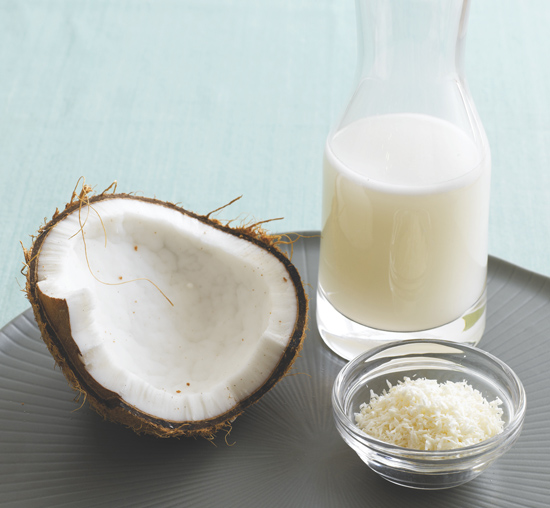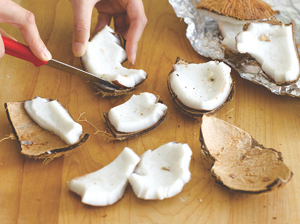

To you I say, “Moo.” Who am I to moo at you? A woman who finds alternative milks udderly intoxicating.
Don’t get me wrong: I am a meat-avore and a dairy enthusiast. But as much as I would love to have old Bessie tied up in the backyard, I’m fairly certain that my neighbors would complain and my dachshund would go ballistic. If city life does not allow me to milk my own, the next best thing is for me to make my own milk.
Milks from nuts and beans are rich, flavorful, and versatile, useful in everything from a sauce to a sweet milkshake to fresh tofu (if you’ve never had the pleasure of eating fresh tofu curds, I encourage you two to meet). Some are a cinchy snap, while others are a bit more labor-intensive. But all are entirely worth the effort. Bessie, it’s time for us to milk it.
I crave this on hot days just because it’s insanely delicious and it makes me feel purely hydrated when I imbibe it. Kinda nutty, kinda creamy, it’s a nice change on cereal, warmed up in your chai, or as a substitute for the milk in ice cream. My favorite, however, is drinking it straight from the Mason jar. Oh, and feel free to sweeten it up to your taste: a lot of people like to blend in dates, maple syrup, agave syrup, barley malt, or some other natural sugar. For me, almond milk is sweet enough on its own. While soaking the almonds yields a much sweeter, smoother, more full-flavored milk, you can get by in a pinch just using raw, dry almonds (or hazelnuts, or cashews). Note that a blender is required.
Makes about 3½ cups
TIME COMMITMENT at least 6 hours
1 cup raw almonds
4 cups water
INSTRUCTIONS Soak the almonds in water to cover by 1 inch for at least 6 hours or overnight. They will plump up by about 30 percent while soaking.
Drain the almonds and place them and the water in the blender. Blend on the highest setting for a full 2 minutes.
Pour the milk through a fine-mesh strainer, pressing down on the solids as you go. Discard the solids and strain the milk one more time, this time not squeezing the solids.
The milk is ready to drink immediately: try it straight up or over ice.
HOW TO STORE IT Kept refrigerated, almond milk will last for 5 days. Frozen, it will last for up to 4 months.
If you’ve been buying that stuff in the carton, you’ve been paying like a sucker. A cup of rice and some tap water are all that’s needed to produce a superfresh, superflavored dairy-free alternative for your morning bowl of flakes and more. Note that a blender is necessary for this recipe.
Makes about 4 cups
TIME COMMITMENT at least 6 hours
1 cup long-grain white rice
4 cups water
4 tablespoons sugar (optional)
INSTRUCTIONS Soak the rice in the water for at least 6 hours or overnight. Transfer the rice and the soaking liquid to the blender and whirl on its highest speed for a full 2 minutes. If you’re using sweetener, blend it in with the rice. Strain through a fine-mesh strainer and discard the solids. Enjoy immediately, or serve cold or over ice.
HOW TO STORE IT Kept refrigerated, rice milk will last for up to 1 week. Frozen rice milk will keep for up to 4 months.
INSTRUCTIONS As anyone who lives within sniffing distance of a taqueria can tell you, horchata is an outrageously enjoyable beverage made from rice milk. On a hot day and/or with hot food, its sweet cinnamon coolness is most welcome. To make it, make the Rice Milk and soak 1 (3-inch) cinnamon stick in the water along with the rice. Include the cinnamon stick in the blender when pureeing the rice, along with a pinch of kosher salt and 4 tablespoons of your favorite sugar or natural sweetener, adding more to taste. Strain and enjoy immediately, or serve cold or over ice.
HOW TO STORE IT Horchata will keep in the refrigerator for 3 days, but it does not freeze well.

We have grown so used to coconut milk in cans that most of us don’t even know what fresh coconut milk tastes like. Let me be the first to demystify this: homemade coconut milk actually tastes like coconut. For the record, I will also state that coconut milk should not be confused with coconut water, that addictive, refreshing clear beverage that comes from inside a young coconut. Nor should this be mistaken for cream of coconut, which is superthick and sweet and is often used in desserts and creamy cocktails. This is coconut milk, the foundation of many an excellent curry. I present two options for making your own, depending on your level of geekdom. One starts with shredded store-bought coconut, and the other starts with the whole fresh nut. To go the latter route, be sure to purchase mature coconuts, often sold as brown orbs with the husks removed, sometimes labeled “coco seco.” “Thai” coconuts or “young” coconuts aren’t what you want for this job.
TIME COMMITMENT 1½ to 2 hours
Makes about 1⅔ cups
2 cups water
2 cups shredded unsweetened coconut
INSTRUCTIONS In a small, covered saucepan, bring the water to a boil. Stir in the coconut, turn off the heat, cover, and let sit for 1 hour.
Once the coconut has steeped, pour the contents of the pan into a dishtowel-lined bowl. Gather all four corners of the towel and lift up the coconut mass, allowing the liquid to drip into the bowl beneath. Twist and squeeze the towel to harvest as much liquid as you can. Discard the solids. This liquid is your milk, and it’s ready to be used in cooking.
HOW TO STORE IT Kept in an airtight container, coconut milk can be refrigerated for up to 5 days (however, note that it may separate after a couple of days and will need to be stirred before use). Frozen, it will last for up to 1 year.

Makes about 2¼ cups
1 whole mature coconut
3 cups water
INSTRUCTIONS Preheat the oven to 350°F.
First, drain the coconut’s water. Take your coconut and find the eyes: the small brown circles near the top. With a hammer and a screw or nail, bang holes into two of the eyes (you need 2 holes to let the air in so the water can flow out). Pour the water directly into a drinking glass and refresh yourself; wielding a hammer is hard work.
Place the drained coconut into a large plastic bag (this will reduce the mess) and take it and the hammer outside. Shatter the giant nut into large pieces. Wrap the smashed coconut pieces tightly in aluminum foil and bake for 30 minutes. This will make very simple work of removing the nut from its shell.
Take the coconut pieces from the oven and, using a paring knife, remove the meat from the shell. Grate or finely chop the coconut by hand or in a food processor; you should have about 3 cups. In a saucepan, boil the 3 cups of water (or use an amount equal to your volume of coconut) and add the coconut. Lower the heat and simmer for 10 minutes, covered. Turn off the heat and let the coconut sit for 1 hour.
Line a bowl with a clean kitchen towel and pour the coconut mash and its liquid into the center. Bring the four corners of the towel together and lift the towel from the bowl; the coconut milk will drip out from the bottom. Tightly twist and squeeze the towel to release as much of the liquid as possible. The milk is now ready to use. Bonus: Your hands will be incredibly soft from the coconut fat.
HOW TO STORE IT Kept in an airtight container, coconut milk can be refrigerated for up to 5 days (however, note that it may separate after a couple of days and will need to be stirred before use). Frozen, it will last for up to 1 year.
Whether you’re enjoying this on cereal or in your coffee, or you’re crafting the start to your own tofu, making your own soy milk is laborious but simple. Why there exists a cabinet-hogging device designed just for this purpose, I’ve not a clue: simply soak, blend, strain, and steam, and soy milk is yours. To make it taste more like the stuff you buy in a carton, add some sugar or other flavorings. Note that a blender or food processor is required for this recipe. Some people like to reserve the okara, the solid mass strained from the milk, and use it as a protein source for soups, breads, smoothies, and so on.
Makes about 9 cups
TIME COMMITMENT About 15 hours
2½ cups dried soybeans
INSTRUCTIONS Soak the soybeans in 8 cups of water for at least 12 hours but no more than 24. Drain the water and rinse the beans thoroughly.
Set a large fine-mesh sieve (or a colander lined with a thin kitchen towel) over a large bowl. In a blender or food processor, puree the beans in batches of 1 cup of beans with 1½ cups of water, for 2 to 3 minutes per batch, ensuring that the beans are as pulverized as possible. (Sit back, relax, and enjoy the cracking sound.) Pour the mixture through the sieve into the bowl. Stir and press down on the solids to release as much liquid as possible, then discard them or set them aside for another purpose. Continue pureeing and straining in batches until the beans are all processed. You will likely need to remove the solids from the sieve several times during the straining process.
Wash out the sieve (or use a clean towel) and strain the soy milk a second time, moving it from the bowl to a heavy stockpot. Heat over medium-high heat until the soy milk starts to steam; don’t let it boil. Stir often, as the soy milk can stick to the bottom and sides of the pan. Lower the heat as needed to keep the milk steaming for 25 minutes, continuing to stir occasionally. It will now have a cooked flavor. At this point, your soy milk is ready to drink. If you’re adding sweetener or other flavorings (see sidebar), add them during the last 5 minutes of cooking time and stir to combine.
Drink either warm or cold.
HOW TO STORE IT Refrigerated, the soy milk will keep for up to a week.
INSTRUCTIONS To make sweetened soy milk, add 1½ teaspoons sugar for every cup of soy milk (or, if your plan is to sweeten the whole batch, add ¼ cup sugar, and then an additional tablespoon to taste). Or, try 4 teaspoons honey, maple syrup, or chocolate syrup, and/or ¼ teaspoon almond or vanilla extract, per cup of soy milk.
Time is no friend to tofu, and its flavor is absolutely the best when it’s super-duper fresh. Similar to the way that milk becomes cheese, soybeans become tofu by first crafting soy milk, adding a coagulant to make curds, and then pressing the curds into shape. And while this isn’t a practical dinner solution every night, the effort is entirely worth what you end up with; silken, soft, fresh tofu best prepared with the lightest hand (green onion, soy sauce, and a squeeze of lemon). Other coagulants exist for making tofu, but I far prefer the clean flavor of natural food-grade nigari (chemical name, magnesium chloride). It’s pretty easy and inexpensive to find online; I buy mine from GEMCultures.com. Feel free to shell out for a fancy cheese press or a classic square wooden tofu press. I prefer to use an empty 28-ounce can with both lids removed.
Makes 3 cups soft tofu curds
TIME COMMITMENT from 1 hour to 1 day
9 cups unflavored, unsweetened soy milk, homemade (opposite page) or store-bought
2 teaspoons nigari (magnesium chloride)
INSTRUCTIONS In a large, uncovered Dutch oven, warm the soy milk over medium heat until it starts to release steam; do not let it boil. Stir occasionally to keep the heat even. Allow the soy milk to steam for 10 minutes.
Remove ⅓ cup of the warmed soy milk from the pot and pour into a bowl. Add the nigari to the bowl, mixing well to dissolve and combine.
Slowly and evenly pour the nigari slurry back into the pot, mixing it in with a ladle or large spoon using an up-and-down motion to distribute the coagulant evenly throughout the soy milk. Turn off the heat, cover, and let sit for 5 minutes to allow the curds to form. If the milk is not curdled throughout, slowly and carefully stir up and down again in spots as necessary, being careful not to break up any existing curds. Cover again and let it sit for an additional 3 minutes.
Pour the contents of the pot through a fine-mesh sieve, discarding the strained-out liquid. Stir the curds lightly and let them drain for 20 minutes. The tofu curds are ready to eat immediately, and they are really delicious while still warm.
If you want to press the tofu into a round cake, fold a clean kitchen towel over a plate (this will help absorb the pressed liquid). Place an empty 28-ounce can with both lids cut out (and retained) on top (or use a tofu press or cheese press). Set the bottom lid in place and spoon the well-drained curds into the mold. Lay the second lid from the can (or the top of the press) over the curds and add some weight on top, such as a pint jar filled with water. The longer you let the tofu sit, the firmer it will become. For medium-firm tofu, let it sit for 2 hours.
Carefully remove the finished tofu from the press; it’s ready to eat.
HOW TO STORE IT Tofu will keep, submerged in water and refrigerated, for up to 5 days.